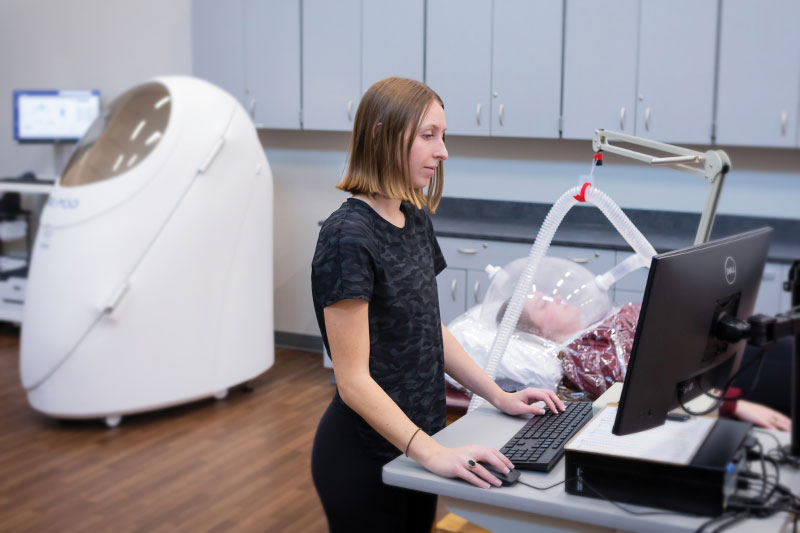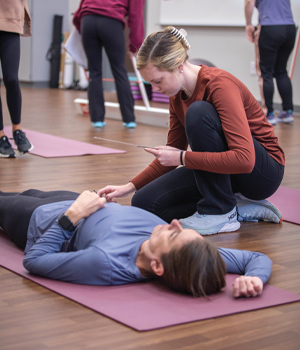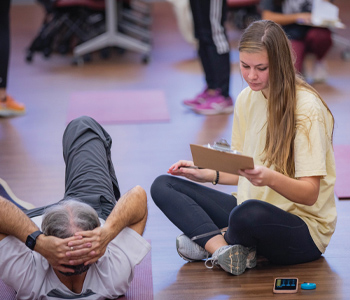
Students Gain Real-World Experience Through Clinical Exercise Program
By Gaye Hill
Students Gain Real-World Experience Through Clinical Exercise Program
By Gaye Hill
Meredith College piloted a new clinical exercise program in fall 2022. The course provides practical experience for Health, Exercise, and Sport Sciences (HESS) students enrolled in ESS 486: Exercise Prescription. Seniors learn how to train individuals who have health conditions such as cardiovascular disease, pulmonary disease, orthopedic conditions, and metabolic disorders.
 Meredith faculty and staff volunteered to serve as clients for the students. Program participants received pre- and post-exercise testing and an 8-week, twice-per-week personal training regime. Training sessions were held in the Lowery Fitness Center, while testing was conducted in the Health & Human Performance Lab located in the new Communication and Health, Exercise & Sport Sciences (CHESS) Building.
Meredith faculty and staff volunteered to serve as clients for the students. Program participants received pre- and post-exercise testing and an 8-week, twice-per-week personal training regime. Training sessions were held in the Lowery Fitness Center, while testing was conducted in the Health & Human Performance Lab located in the new Communication and Health, Exercise & Sport Sciences (CHESS) Building.
Assistant Professor of Health, Exercise, and Sports Science Heather Sanderson provided oversight during testing and training sessions. Although the course itself is not new, Sanderson added the clinical exercise program to provide HESS students with a cumulating experiential learning opportunity.
“It incorporates what they have learned in their ESS courses for the past three years and prepares them for their upcoming internship or practicum and even the next step in their career path,” said Sanderson.
She welcomed the opportunity for students to apply theories and principles in kinesiology and exercise within a real-world situation.
It incorporates what they have learned in their ESS courses for the past three years and prepares them for their upcoming internship or practicum and even the next step in their career path,” said Sanderson.
“They learned the intricacies of screening, testing, designing, and training exercise programs for a clinical population along with exercise psychology, motivation and health behavior strategies, and effective communication,” said Sanderson. “In addition, for many students, this was the first time they had to write Subjective, Objective, Assessment, and Plan (SOAP) notes, which is a form of clinical documentation.”
Senior ESS major Logan Byrd said her favorite part of participating in the clinical exercise class was being able to connect with a member of the Meredith community.
“It was great to see my client grow and become more confident as the semester progressed,” said Byrd. “It was truly rewarding to be able to educate my client so she could continue to be physically active after this course.”
This experience directly contributed to Byrd’s career plans.
“It has always been my goal to become a physical therapist,” she said. “This class has better prepared me with skills such as client-to-trainer communication, assessing conditions, planning exercise programs, and assisting clients with their goals. I believe the course material and overall experience will have a lasting impact on my health and wellness career path.”
A Mutually Beneficial Program
Sanderson sees the program as one that benefits both students in the course as well as faculty and staff participants.
“Learning how to perform safe and effective movements and how the body responds to exercise strengthens a person’s confidence and competence with their own body,” she said. “This is so valuable as many individuals simply do not understand their own health and struggle with basic activities of daily living. After the program, I hope they will continue their healthy, active lifestyle.”
Sanderson said she has received emails from faculty and staff sharing how much they have benefited by learning from the students and appreciated the support towards their own personal health and well-being.
Counseling Center Director Beth Meier saw clear benefits from participating in the program.
“I had always taken time to exercise and attend to my osteopenia but when the pandemic happened that all went by the wayside,” said Meier. “I now have osteoporosis and was motivated to get back on track.”
 Meier commended her work with her student trainer, saying she was surprised to make real gains in her endurance and strength in just a few weeks.
Meier commended her work with her student trainer, saying she was surprised to make real gains in her endurance and strength in just a few weeks.
Carolyn Koning, assistant director of disability services, had a similar experience in that the pandemic derailed her workout program. She had previously worked individually with an ESS major who needed a client so she was excited to do so again in order to regain healthy habits.
“My student trainer tailored activities and exercises to my personal goals and fitness level,” said Koning. “I was never sore after workouts, and she made sure I did exercises correctly to avoid injuries. She taught me new exercises that target my training goals. I feel stronger after working with Peyton this semester.”
Koning noted another benefit was getting to know a student she would not have otherwise interacted with. Her trainer works in the Meredith Autism Program so they had a shared interest in working with people with disabilities.
Given its success, Sanderson intends to repeat the program.
“I am thrilled about the program and how both students and faculty/staff have bonded and learned from each other,” said Sanderson. “I appreciate the feedback faculty and staff have given to the students to support their learning and look forward to offering it again in the future.”
